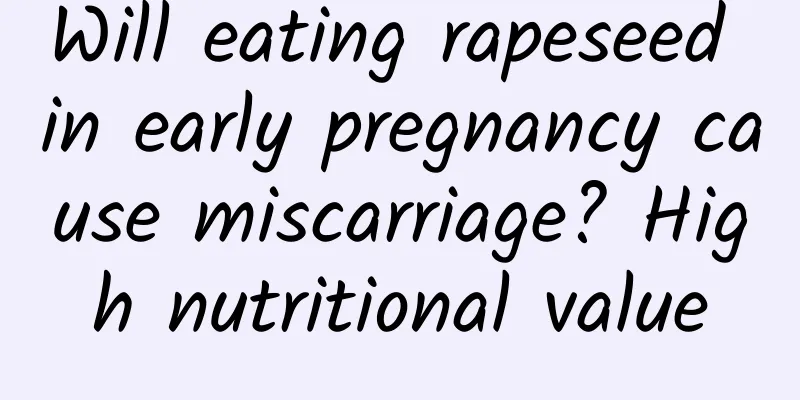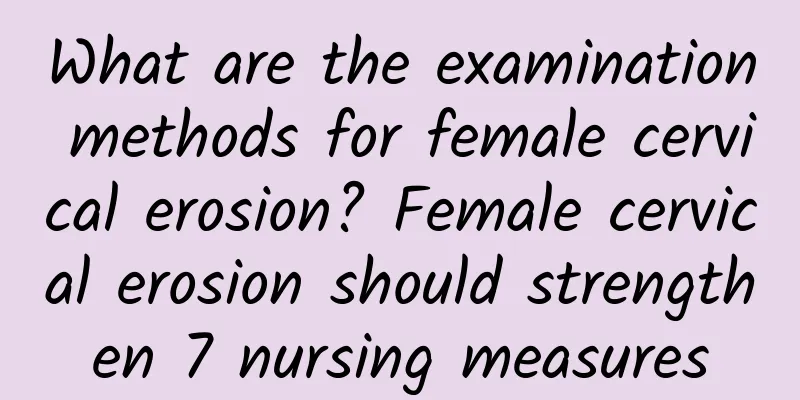46 years old, my period has come for half a month and it is still not over. What's wrong?

|
Normal menstruation for women usually lasts 3 to 7 days. If it lasts more than 10 days, it is considered as prolonged bleeding. There are many reasons for prolonged menstrual bleeding. Let's take a look at the reasons why menstruation has not stopped for half a month at the age of 46. Blood disorders Blood diseases can cause women to have menstruation that lasts for more than ten days. For example, thrombocytopenic purpura and aplastic anemia are often accompanied by menstruation. If there is severe uterine bleeding, the menstrual period will be prolonged. Other diseases such as chronic anemia, chronic hepatitis, cirrhosis, nephritis, etc. can make the blood vessel wall fragile and increase permeability, causing bleeding, making menstruation last for more than ten days. Inflammatory diseases Inflammatory diseases are also the reason why women's menstruation has not ended for more than ten days. For example, pelvic inflammatory disease, endometritis, myometritis and other parasitic inflammatory diseases are caused by poor blood circulation, degeneration and necrosis or pelvic congestion, which lead to excessive menstruation and menstruation has not ended for more than ten days. Endometrial polyps Endometrial polyps are mainly caused by excessive estrogen levels and long-term inflammatory stimulation. Clinical manifestations include irregular vaginal bleeding, increased menstruation, prolonged menstruation, menstrual disorders, infertility, etc. Therefore, endometrial polyps are also one of the reasons why menstruation has not ended for more than ten days. Uterine fibroids There are three types of uterine fibroids, including subserous, intramural and submucosal. If the uterine fibroid is subserous, or the uterine fibroid is small and located in the myometrium, it will generally not affect menstruation. If the uterine fibroid is located under the mucosa, or the uterine fibroid is large and located in the intramural area, it will compress the endometrium or increase the area of the endometrium, then during menstruation, the endometrium will not be completely shed, resulting in heavy and continuous menstruation. Dysfunctional uterine bleeding Dysfunctional uterine bleeding, also known as functional uterine bleeding or uterine bleeding, is a non-organic disease caused by abnormal endometrial bleeding due to neuroendocrine disorders. It is generally divided into two categories: anovulatory and ovulatory. Ovulatory uterine bleeding often occurs during the reproductive age. Due to insufficient luteal function or prolonged atrophy, the menstrual cycle is shortened and the menstruation may not end after more than ten days. Endometriosis Under normal circumstances, the endometrium covers the surface of the uterine cavity. If due to some factors, the endometrium grows in other parts of the body, it can become endometriosis. This ectopic endometrium histologically not only has endometrial glands, but is also surrounded by endometrial stroma. Its function changes significantly with the estrogen level, that is, it changes with the menstrual cycle, but only part of it is affected by progesterone, affecting the contraction of the uterine muscle layer or the enhancement of the endometrium, thereby producing a small amount of "menstruation" and causing the phenomenon that the menstruation has not ended for more than ten days. Intrauterine device If a woman who has had a normal IUD has a period that lasts for more than ten days, it is considered to be due to the influence of the IUD. The main discomforts after IUD insertion include: lower abdominal discomfort, increased leucorrhea, a small amount of vaginal bleeding, slight backache, or increased menstrual volume, which generally disappear quickly or gradually disappear within three months, and no special treatment is required. If the bleeding is heavy or frequent, you should go to the hospital for treatment to observe whether the IUD is displaced, detached, or has endometritis and other abnormal conditions. If the menstrual volume often increases and drips continuously after IUD insertion, if there is no improvement after hemostasis and anti-inflammatory treatment, you can consider temporarily removing the IUD and inserting it again after the menstruation returns to normal for 2-3 cycles. |
>>: Can you eat pineapple during menstruation? Ladies, please read this carefully
Recommend
How do women treat cervical erosion? Patients with cervical erosion try eight folk remedies
Cervical erosion has a great impact on women'...
What are the symptoms of pelvic effusion?
Pelvic effusion refers to the abnormal accumulati...
Details that patients with ectopic pregnancy should pay attention to in their lives
Nowadays, ectopic pregnancy is a common gynecolog...
Detailed description of the harm of uterine fibroids to women
Nowadays, uterine fibroids are becoming more and ...
Why does uterine fibroids cause low blood pressure and dizziness? Can uterine fibroids cause low blood pressure?
Why does uterine fibroids cause low blood pressur...
Is there a high chance of curing dysmenorrhea?
Is the probability of dysmenorrhea being cured hi...
How much does it cost for women to undergo endometrial tuberculosis surgery?
How much does the surgery for endometrial tubercu...
How long does uterine fibroid surgery take? 4 factors affect uterine fibroid surgery
The time required for uterine fibroid surgery can...
Use "adiponectin" to make weight loss easier. Make good use of "soy dregs powder" to supplement slimming hormones
Next, I will introduce recipes for mixing drinks,...
Do you know the symptoms of cervical hypertrophy?
What symptoms do you know about cervical hypertro...
Is adnexitis the same as pelvic inflammatory disease?
In life, many female friends have very vague defi...
Unable to control appetite, ruining weight loss efforts? Chinese medicine doctor Zhang Wenxin: To defeat the "little hunger demon", first help your body put out the fire
My appetite is too strong and I can’t control it ...
Vulvar infection and inflammatory irritation can cause vulvar leukoplakia
Vulvar leukoplakia refers to localized or diffuse...
Can I have an IUD inserted while having an abortion?
Can I have an IUD inserted while having an aborti...
Experts teach you how to correctly prevent ectopic pregnancy
Although the incidence of ectopic pregnancy is no...









